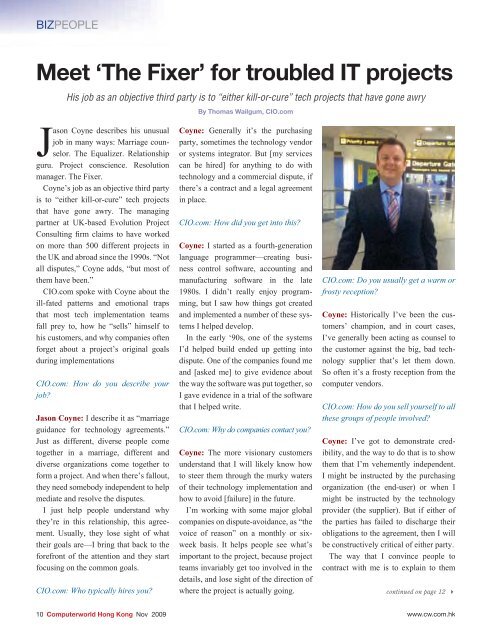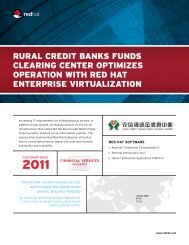Hong Kong Computer Society - enterpriseinnovation.net
Hong Kong Computer Society - enterpriseinnovation.net
Hong Kong Computer Society - enterpriseinnovation.net
Create successful ePaper yourself
Turn your PDF publications into a flip-book with our unique Google optimized e-Paper software.
BIZPEOPLE<br />
Meet ‘The Fixer’ for troubled IT projects<br />
His job as an objective third party is to “either kill-or-cure” tech projects that have gone awry<br />
By Thomas Wailgum, CIO.com<br />
Jason Coyne describes his unusual<br />
job in many ways: Marriage counselor.<br />
The Equalizer. Relationship<br />
guru. Project conscience. Resolution<br />
manager. The Fixer.<br />
Coyne’s job as an objective third party<br />
is to “either kill-or-cure” tech projects<br />
that have gone awry. The managing<br />
partner at UK-based Evolution Project<br />
Consulting firm claims to have worked<br />
on more than 500 different projects in<br />
the UK and abroad since the 1990s. “Not<br />
all disputes,” Coyne adds, “but most of<br />
them have been.”<br />
CIO.com spoke with Coyne about the<br />
ill-fated patterns and emotional traps<br />
that most tech implementation teams<br />
fall prey to, how he “sells” himself to<br />
his customers, and why companies often<br />
forget about a project’s original goals<br />
during implementations<br />
CIO.com: How do you describe your<br />
job?<br />
Jason Coyne: I describe it as “marriage<br />
guidance for technology agreements.”<br />
Just as different, diverse people come<br />
together in a marriage, different and<br />
diverse organizations come together to<br />
form a project. And when there’s fallout,<br />
they need somebody independent to help<br />
mediate and resolve the disputes.<br />
I just help people understand why<br />
they’re in this relationship, this agreement.<br />
Usually, they lose sight of what<br />
their goals are—I bring that back to the<br />
forefront of the attention and they start<br />
focusing on the common goals.<br />
CIO.com: Who typically hires you?<br />
Coyne: Generally it’s the purchasing<br />
party, sometimes the technology vendor<br />
or systems integrator. But [my services<br />
can be hired] for anything to do with<br />
technology and a commercial dispute, if<br />
there’s a contract and a legal agreement<br />
in place.<br />
CIO.com: How did you get into this?<br />
Coyne: I started as a fourth-generation<br />
language programmer—creating business<br />
control software, accounting and<br />
manufacturing software in the late<br />
1980s. I didn’t really enjoy programming,<br />
but I saw how things got created<br />
and implemented a number of these systems<br />
I helped develop.<br />
In the early ‘90s, one of the systems<br />
I’d helped build ended up getting into<br />
dispute. One of the companies found me<br />
and [asked me] to give evidence about<br />
the way the software was put together, so<br />
I gave evidence in a trial of the software<br />
that I helped write.<br />
CIO.com: Why do companies contact you?<br />
Coyne: The more visionary customers<br />
understand that I will likely know how<br />
to steer them through the murky waters<br />
of their technology implementation and<br />
how to avoid [failure] in the future.<br />
I’m working with some major global<br />
companies on dispute-avoidance, as “the<br />
voice of reason” on a monthly or sixweek<br />
basis. It helps people see what’s<br />
important to the project, because project<br />
teams invariably get too involved in the<br />
details, and lose sight of the direction of<br />
where the project is actually going.<br />
CIO.com: Do you usually get a warm or<br />
frosty reception?<br />
Coyne: Historically I’ve been the customers’<br />
champion, and in court cases,<br />
I’ve generally been acting as counsel to<br />
the customer against the big, bad technology<br />
supplier that’s let them down.<br />
So often it’s a frosty reception from the<br />
computer vendors.<br />
CIO.com: How do you sell yourself to all<br />
these groups of people involved?<br />
Coyne: I’ve got to demonstrate credibility,<br />
and the way to do that is to show<br />
them that I’m vehemently independent.<br />
I might be instructed by the purchasing<br />
organization (the end-user) or when I<br />
might be instructed by the technology<br />
provider (the supplier). But if either of<br />
the parties has failed to discharge their<br />
obligations to the agreement, then I will<br />
be constructively critical of either party.<br />
The way that I convince people to<br />
contract with me is to explain to them<br />
continued on page 12 4<br />
10 <strong>Computer</strong>world <strong>Hong</strong> <strong>Kong</strong> Nov 2009 www.cw.com.hk














